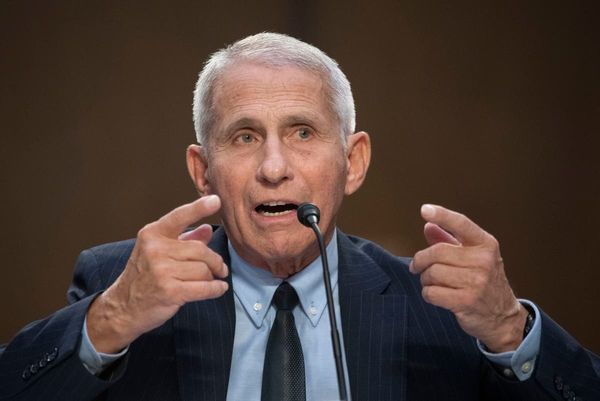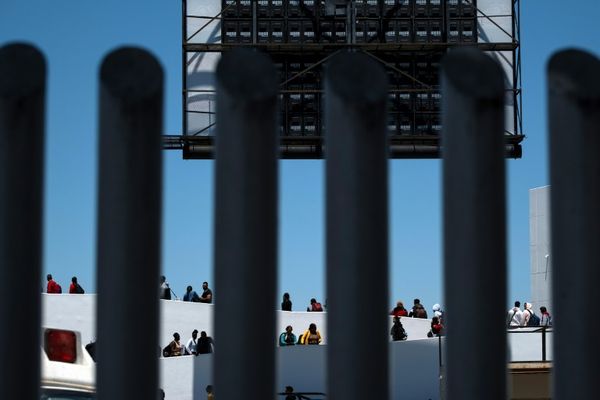
The eastern Ukrainian city of Kharkiv, some 30km from the Russian border, has suffered grievously in the past year. Cruise missiles and shells rained down on it brutally last spring, killing hundreds of civilians, blasting the imposing regional government building and the opera house, cratering apartment blocks, shops, schools, churches and university buildings.
Having withstood the Russian assault, the city is now in a state of tentative recovery, despite the occasional artillery hit. Though many buildings are boarded up or ruined, shops and cafes are opening up in pockets. On a recent spring day, teams of volunteers were out tending streetside flowerbeds and sweeping the public squares.
In the early days of February 2022, artist Mykola Kolomiets had no idea of the momentous and deadly events that were coming his way. Instead, he was preparing for an exhibition. The show was planned to celebrate a decade of Aza Nizi Maza, the children’s art workshops he’d been running in his studio in the centre of the city.
“No one believed that the war was going to start,” says Kolomiets, sporting an orange woolly hat and an infectious grin, “even though we were warned by the experts. My girlfriend joked that the studio would make the perfect bomb shelter.”

You can see why: the studio is a labyrinthine, subterranean series of interconnected rooms. What it lacks in natural light – I spot a single window, taped up against the possibility of shattering glass – it makes up for in colour. Every surface is bright with the traces of old paint, and walls are thickly papered with artworks tacked to sheets of chipboard. A large table in the main room is heaped with children’s drawings and illustrated books for them to delve into for inspiration – everything from volumes of botanical illustrations to works on Picasso and Egyptian antiquities.
The quip about the air-raid shelter, though, turned out to be not so much of a joke when they looked at the map of safe refuges the city authorities circulated: the studio was marked on it. “It was a bit of a mess, so we started to clean it up, ready to receive people,” Kolomiets says.
They also prepared to sleep there themselves. Kolomiets even evacuated his aquarium and its piscine inhabitants – who are still in residence at the studio – from his 1920s apartment block a couple of kilometres away. Just as well: the block, the Slovo Building, originally designed to house Kharkiv’s writers, intellectuals and journalists, who were later brutally purged by Stalin, took a partial hit in the shelling (it is, thankfully, still standing).
Kolomiets and his girlfriend didn’t have to wait long for company. “As it turned out, all the other shelters nearby were in a terrible condition,” he says. People living and working nearby soon found their way to the studio – including the entire staff of a nearby Turkish restaurant. “They helped a lot to keep the place going, and they brought a lot of food.”

At the height of the shelling, in March and April, some 50 people were sleeping in the studio. The first civilian killed in the city died in their street. At one point in March a piece of shrapnel blasted through to the studio. Kolomiets holds out the twisted scrap of metal to show me: no one inside was hurt, but it’s a reminder of that terrifying period. The last among those sleeping there left in August.
In the meantime, Kolomiets decided that the art classes he’d been holding for kids could not stop. He decided, with an artist colleague, to go to the nearby Historical Museum underground station, where hundreds of Kharkivians slept during the worst of the bombardment – an experience vividly brought to life in the song Metro by Serhiy Zhadan, the poet, novelist and frontman of the ska band Zhadan and the Dogs.
One part of the grandiose, lofty halls of the Soviet-era station was reserved for sleeping quarters. The other was kept free for activities – breakdancing, for example, to try to give the subterranean inhabitants a bit of exercise – as well as some maths, literature and science taught by a woman the children called “Maria Biscuit”, owing to her doubtless sensible notion of resorting to bribery to entice the kids to learn.
It was here that Kolomiets set to work with around 15 children. “We joked that I’d always been dreaming of having a really big studio,” he says. “And here it was.” For 40 consecutive days from March to May, he ran art classes in the underground.

Kolomiets explains how he worked: he’d start to draw a figure, and ask the children what they thought it might be. One might be a soldier, they’d say, one a volunteer – and they’d work from there. One little boy, Oleksii, spent days drawing and colouring in the tiny pixellated squares that went to form the soldier’s camouflage jacket. “It was good to do this repetitious work, switching off your brain, concentrating on patterns,” Kolomiets says.
Sometimes he’d leave drawing materials out for the children overnight, and come back in the morning to find something new under way – a picture of a bee, or of an eye, say – and they’d work out how to incorporate the fresh drawings into the large works on paper that were taking shape.
“The children were always waiting for us,” he says. “They’d come right up to the top of the escalator in the morning.” Not just the children, he adds – adults, too, and the station workers would make sure as many lights as possible were switched on to allow them to work.

The drawings, Kolomiets tells me, are still there, by order of the mayor of Kharkiv – so I head to the underground station. There they are, attached to the great pillars that run the length of the platform, commuters milling about between them. I spot the picture of the soldier whose uniform Oleksii lovingly coloured, with flowers bursting from his automatic rifle and cats pawing at the leg of his fatigues.
I can only imagine the painting of a giant bird, bright with exotic plumage, acted as a reminder of the peaceful, lovely world above that had been shattered by the invasion. Elsewhere I spot the bee and the eye that Kolomiets told me about – they have found their way into an image of a hive that is also a house and, perhaps, a memory of home. A small expectant dog, its ears cocked, is positioned outside.
Back at the studio, Kolomiets proudly shows me some of the work that the young people have been making since the underground emptied of its inhabitants and he resumed regular teaching. Some of them are developing clear individual styles. Anna, who is 14, is currently drawing the destroyed buildings of Kharkiv, with oversize human figures inside.

Khrystyna, also 14, is interested in transforming AI-produced images. Vanya, five, is making portraits massively scaled up. The point is, says Kolomiets, that “we are all unique – and we help you develop that uniqueness. It turns out that Vanya, for example, really blossoms when he has huge scale to play with.”
I wonder about Kolomiets’ own practice as an artist. “I was working on a single painting between 2012 and 2014,” he tells me, “and then the war started.” He is referring to Russia’s illegal incursions into the Crimea and the Donetsk and Luhansk regions, almost a decade ago. When I ask him about that work, he replies: “It was a figure of violence.” When he’d finished it, he says: “I felt I’d accomplished what I wanted to achieve.” He hasn’t made a painting of his own since.
I must look concerned, because he reassures me. Teaching his workshops “is eternal happiness for me”, he says. “I truly experience joy in this.” Even – perhaps especially – when the Russian cruise missiles and artillery rounds pounded down.







